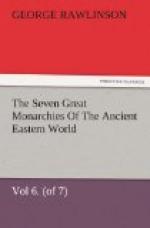Thus ended the great Parthian invasion of Syria, and with it ended the prospect of any further spread of the Arsacid dominion towards the west. When the two great powers, Rome and Parthia, first came into collision—when the first blow struck by the latter, the destruction of the army of Crassus, was followed up by the advance of their clouds of horse into Syria, Palestine, and Asia Minor—when Apamsea, Antioch, and Jerusalem fell into their hands, when Decidius Saxa was defeated and slain, Cilicia, Pamphylia, Caria, Lydia, and Ionia occupied—it seemed as if Rome had found, not so much an equal as a superior; it looked as if the power heretofore predominant would be compelled to contract her frontier, and as if Parthia would advance hers to the Egean or the Mediterranean. The history of the contest between the East and the West, between Asia and Europe, is a history of reactions. At one time one of the continents, at another time the other, is in the ascendant. The time appeared to have come when the Asiatics were once more to recover their own, and to beat back the European aggressor to his proper shores and islands. The triumphs achieved by the Seljukian Turks between the eleventh and the fifteenth centuries would in that case have been anticipated by above a thousand years through the efforts of a kindred, and not dissimilar people. But it turned out that the effort made was premature. While the Parthian warfare was admirably adapted for the national defence on the broad plains of inner Asia, it was ill suited for conquest, and, comparatively speaking, ineffective in more contracted and difficult regions. The Parthian military system had not the elasticity of the Roman—it did not in the same way adapt itself to circumstances, or admit of the addition of new arms, or the indefinite expansion




